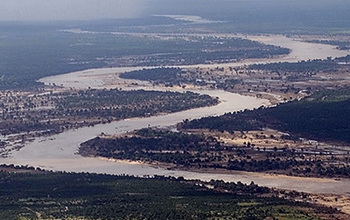Program Director Justin Lawrence Attends Community Surface Dynamics Modeling System (CSDMS) Annual Meeting
July 26, 2018
Op Ed by Justin Lawrence
This spring, I attended the Community Surface Dynamics Modeling System (CSDMS) Annual Meeting for the first time. As a participant, I learned about the latest advances in computational modelling of natural and geohazards. The meeting offered an opportunity to learn more about the research and education topics exciting to this rich and vibrant community.
In particular, presentations about flood risk reminded me of my years growing up in St. Louis, MO. As a child, I explored the shores of the Mississippi and Missouri Rivers. In 1993, I witnessed a major flood event and the response from the community. I wonder now how the disaster response might have been different if St. Louis had access to the sophisticated flood models we have today.
In closing, I very much enjoyed meeting face-to-face with diverse researchers within the CSDMS community, especially early-career scientists preparing to submit their first NSF proposals. Our inspiring conversations reminded me that NSF funds the best and brightest. We put U.S. taxpayer dollars to good use by helping people in our home communities—civic scientists at work.
-----------
Justin Lawrence manages the Geomorphology and Land-use Dynamics (GLD) program in the Division of Earth Sciences. In March, Justin was promoted from associate program director to program director for GLD. He is also part of the management team for the Geosciences Directorate's Prediction of and Resilience against Extreme Events (PREEVENTS) program. PREEVENTS and EarthCube co-funded the CSDMS Annual Meeting. Lawrence made opening remarks.
He can be reached at jlawrenc@nsf.gov and (703) 292-2425 for questions about these programs.
The U.S. National Science Foundation propels the nation forward by advancing fundamental research in all fields of science and engineering. NSF supports research and people by providing facilities, instruments and funding to support their ingenuity and sustain the U.S. as a global leader in research and innovation. With a fiscal year 2023 budget of $9.5 billion, NSF funds reach all 50 states through grants to nearly 2,000 colleges, universities and institutions. Each year, NSF receives more than 40,000 competitive proposals and makes about 11,000 new awards. Those awards include support for cooperative research with industry, Arctic and Antarctic research and operations, and U.S. participation in international scientific efforts.
Connect with us online
NSF website: nsf.gov
NSF News: nsf.gov/news
For News Media: nsf.gov/news/newsroom
Statistics: nsf.gov/statistics/
Awards database: nsf.gov/awardsearch/
Follow us on social
Twitter: twitter.com/NSF
Facebook: facebook.com/US.NSF
Instagram: instagram.com/nsfgov

